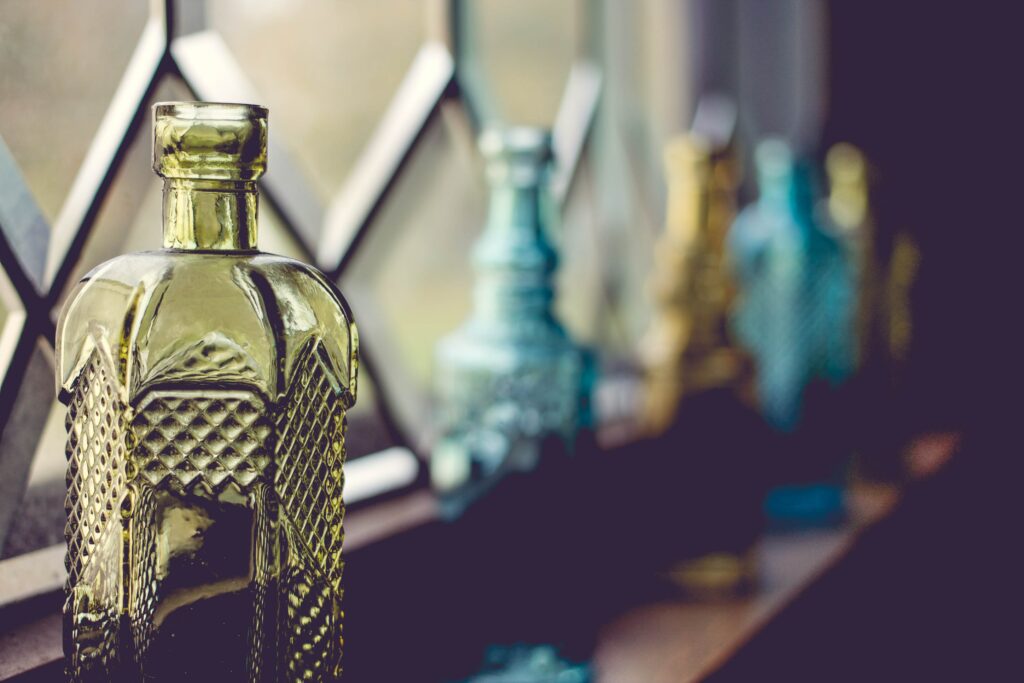
We’ve come to another segment of collector guides for our blog, and just in time to wrap up the 2023 year! We’ve covered Japanese antiques, general fine art, pottery, jewelry, and now… glass!
Glass collectibles are not as boring as you might think. From vintage atomizers, classic Coca-Cola bottles, to art glass sculptures by famous artists, Many collectors and dealers have made quite a handsome buck on especially unique glass items.
In this blog post, we will cover the unique glass antiques that collectors enjoy the most.
Uranium ware
First in the lineup is uranium glassware. Also known as Vaseline glass, this is a type of glass that has a yellow or greenish tint. It gets its color and ultraviolet glow from the addition of uranium oxide during the glassmaking process.
No, you can’t become Hulk or Dr. Manhattan if you eat or drink off it. Please don’t eat off Uranium glass dinnerware. Please.
Uranium glass contains small amounts of radioactive material, the radiation levels are generally considered to be very low and not harmful in everyday use. However, it is recommended to handle uranium glassware with care and avoid ingesting or inhaling any dust or particles from damaged pieces.
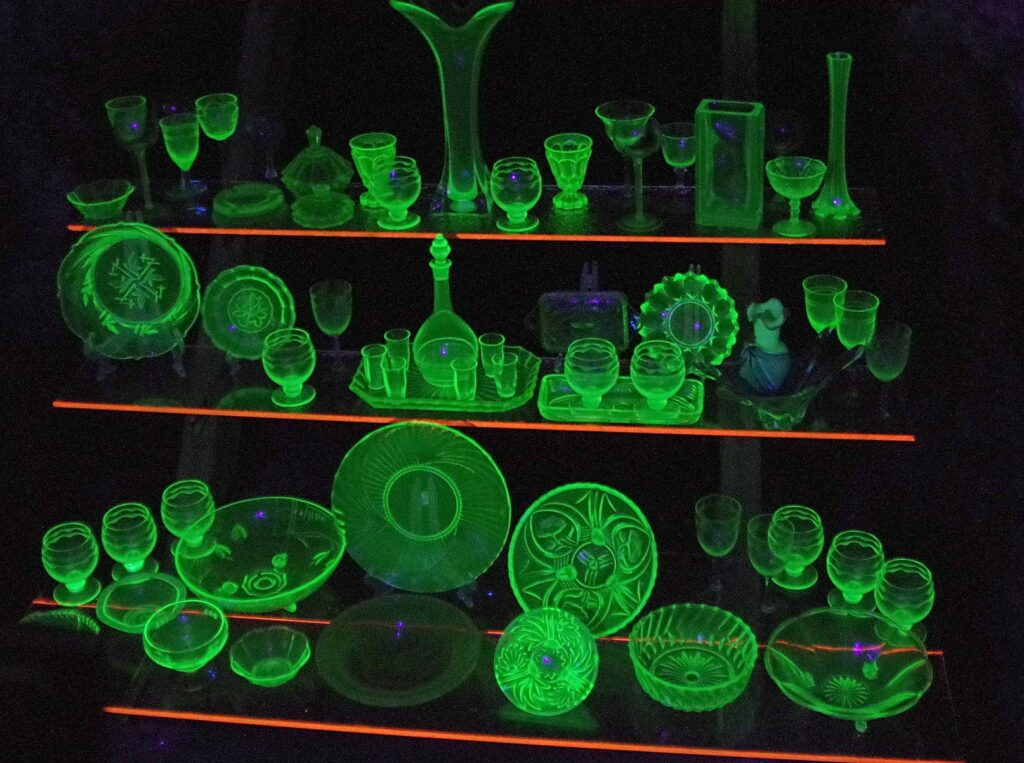
Uranium glassware comes in various forms, including vases, bowls, plates, and even jewelry. Collectors and enthusiasts appreciate its distinct color and the fascinating glow it exhibits under UV light. It's important to note that if you own uranium glassware, it's best to handle it responsibly.
An example of the iconic uranium glass would be this collection of uranium glass on display.
Depression glass
Depression glass refers to a type of colorful glassware that was made and distributed during the Great Depression, which lasted from the late 1920s to the early 1940s. It was produced to be affordable and accessible to people during a time when money was scarce.
Depression glass comes in various vibrant colors such as pink, green, blue, and amber. It was often given away as a promotional item or as part of a purchase incentive, such as by purchasing certain products or attending a movie. People could also collect it by saving box tops or coupons from various products.
This glassware was made in a range of styles and patterns, including plates, bowls, cups, and serving dishes. Some common patterns include "Cherry Blossom," "Cameo," and "American Sweetheart." The designs were often intricate and featured geometric shapes, flowers, or ribbed textures. While depression glass was not considered high-end or luxurious at the time, it gained popularity among collectors due to its nostalgic value and historical importance of a challenging era in American history.
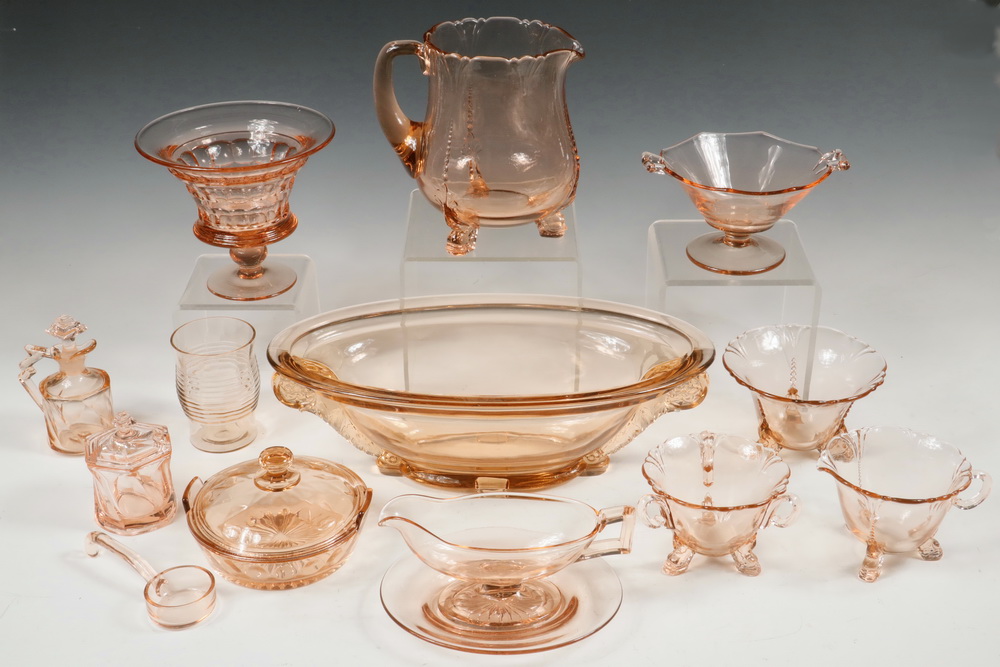
If you own depression glass, it's important to handle it with care as it can be delicate. Washing it by hand is recommended to prevent any damage.
An example of depression glass would be this lot of pink depression glass we sold for $132 in a 2017 auction.
Murano
Murano glass is made on the island of Murano, near Venice, Italy. It has a long history and is known for exceptional craftsmanship. Murano glass is highly regarded and sought after by both collectors and art enthusiasts around the world.
Murano glassmakers pass down their secretive skills through generations in the island guild. Artisans heat the glass to a high temperature until it’s molten, then shape it using various tools to create different forms like vases, bowls, and figures. The glassmakers use techniques like millefiori ("thousand flowers"), where thin glass canes with colorful patterns are fused together, then shaped into different objects.
One distinctive feature of Murano glass is its array of vibrant color. Artisans add different minerals and oxides to the glass mixture, which create a wide range of hues and patterns. Frequent colors include bright blues, reds, greens, and shimmering golds.
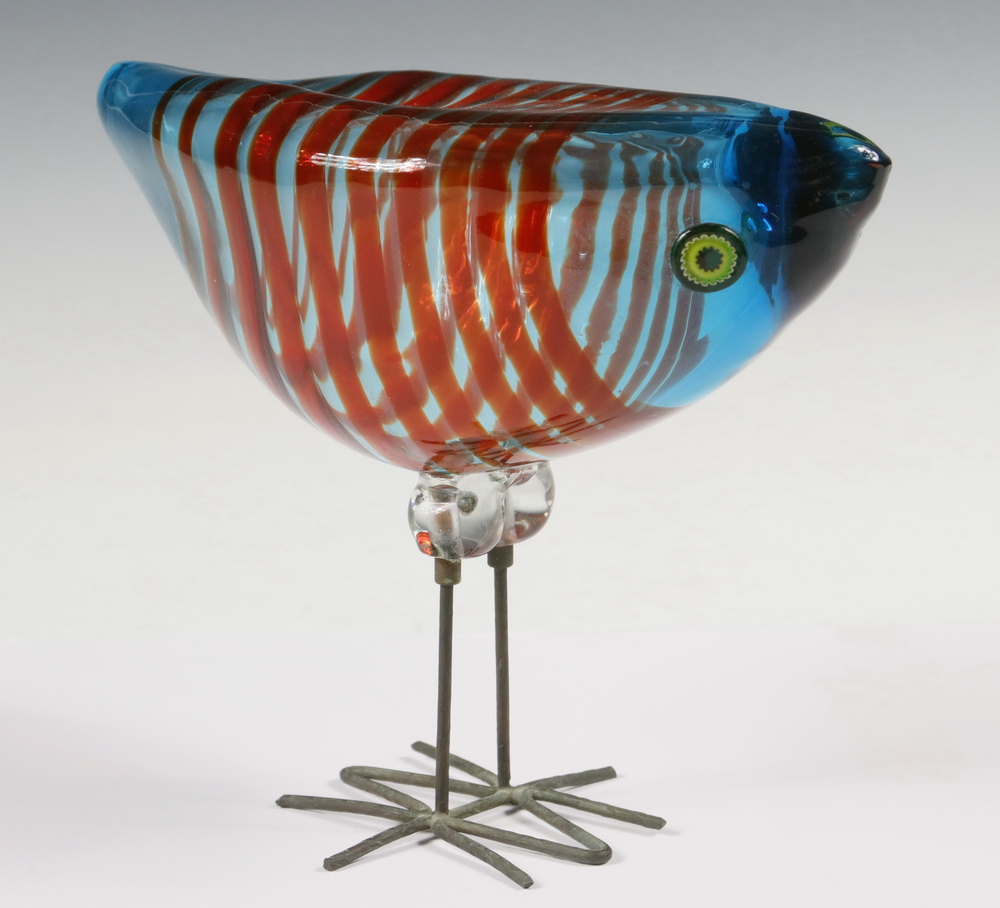
When purchasing Murano glass, it's important to ensure its authenticity, as there are imitations out in the market. Look for the "Vetro Artistico Murano" label, which guarantees the piece is made by a certified Murano artist.
Our favorite piece of Murano art glass we sold so far is this Vistosi Murano bird form by designer Alessandro Pianon, with the final price reaching a whopping $7,406!
Bohemian
Bohemian glass is made in the region of Bohemia, now part of the Czech Republic.
One of the notable characteristics of Bohemian glass is its exceptional clarity and brilliance. The glassmakers strive to achieve a high level of transparency, giving the glass a sparkling and luminous appearance. This quality is achieved through precise control of the melting and cooling process.
Bohemian glass is also famous for its intricate decorations and embellishments. Artisans use various techniques like cutting, engraving, and painting to create beautiful designs on the glass surface. They may incorporate motifs such as flowers, geometric patterns, or even scenes from nature and mythology.
The use of vibrant colors is another hallmark of Bohemian glass. Glassmakers achieve these colors by adding metal oxides to the glass mixture. This results in a wide array of hues, including rich blues, deep reds, emerald greens, and golden yellows.
Bohemian glass has a rich heritage and is highly valued by collectors and enthusiasts worldwide. Each piece is considered a work of art, reflecting the skill and creativity of the glassmakers. Whether used as functional items or displayed as decorative pieces, Bohemian glass adds elegance and beauty to any space. When looking to purchase Bohemian glass, it's important to ensure its authenticity. Genuine Bohemian glass is often marked or labeled to indicate its origin. The "Made in Czech Republic" label or the Bohemian glass symbol are good indicators of its authenticity.

Bohemian glass continues to be cherished for its exquisite craftsmanship, timeless beauty, and artistic value. It stands as a testament to the rich glassmaking traditions of Bohemia and remains a treasured part of the region's cultural heritage.
An example of bohemian glassware we’ve sold in the past includes this set of eight wheel cut cordials for $911.50 in a past auction.
Scandinavian
Scandinavian glassware is solely made in the Scandinavian area, obviously. This region includes Denmark, Sweden, Norway, Finland, and Iceland. Scandinavian glass is known for minimalist designs.
Scandinavian glass is often characterized by simplicity and functionality. The designs are often sleek and modern, with a focus on clean lines and geometric shapes. The glassmakers prioritize creating pieces that are both visually appealing and practical for everyday use.
One of the distinctive features of Scandinavian glass is its transparency. Glassmakers strive for the luminous effect that light naturally brings when reflected. This gives the glass a sense of lightness and elegance.
Scandinavian glass is also known for subtle colors and natural elements. Many pieces feature soft tones like pale blues, greens, and grays, complementing the minimalist aesthetic. Additionally, glassmakers often incorporate nature-inspired motifs such as leaves, flowers, or landscapes, reflecting the region's connection to the surrounding environment.
When buying Scandinavian glass, it's important to look for reputable brands or artists who are known for their quality craftsmanship. Brands include Orrefors and Kosta Boda from Sweden, Iittala from Finland, and Holmegaard from Denmark.
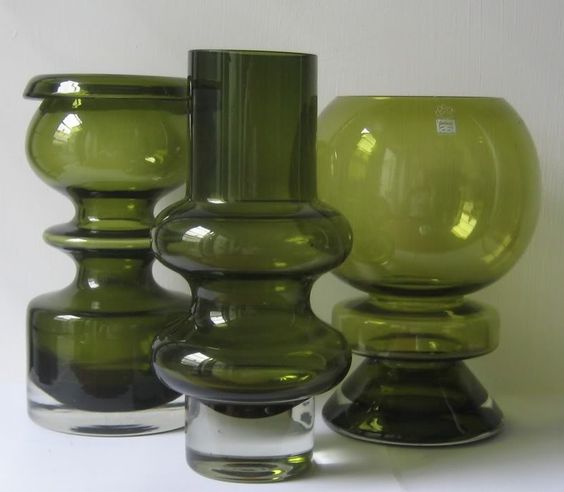
The craftsmanship of Scandinavian glass is highly regarded, with a focus on precision and attention to detail. It embodies the Scandinavian design philosophy of functional elegance, making it a timeless and valuable addition to any home or collection.
While we have not yet sold any Scandinavian glass in a while, here’s an example picture from the Design Forum.
Empoli
Empoli glassware is produced in the town of Empoli of Tuscany, Italy.
Empoli glass gets its reputation for its vibrant colors, often in popular hues of greens, yellows, pinks, blues and reds. Enhancing its beauty with traditional smooth, elegant shapes and curves, it also bears decorative textures like fluting. You can find them in any form like other collectable glassware.
When looking to purchase Empoli glassware, double check its authenticity. Genuine Empoli glass is marked or labeled with "Empoli" or "Made in Italy" to ensure their provenance.
Empoli glass is a testament to the rich glassmaking tradition of the region, and continues to be appreciated for its craftsmanship and unique aesthetic.
While we have not sold Empoli glass in a while, here is an example image of what these collectible pieces look like.
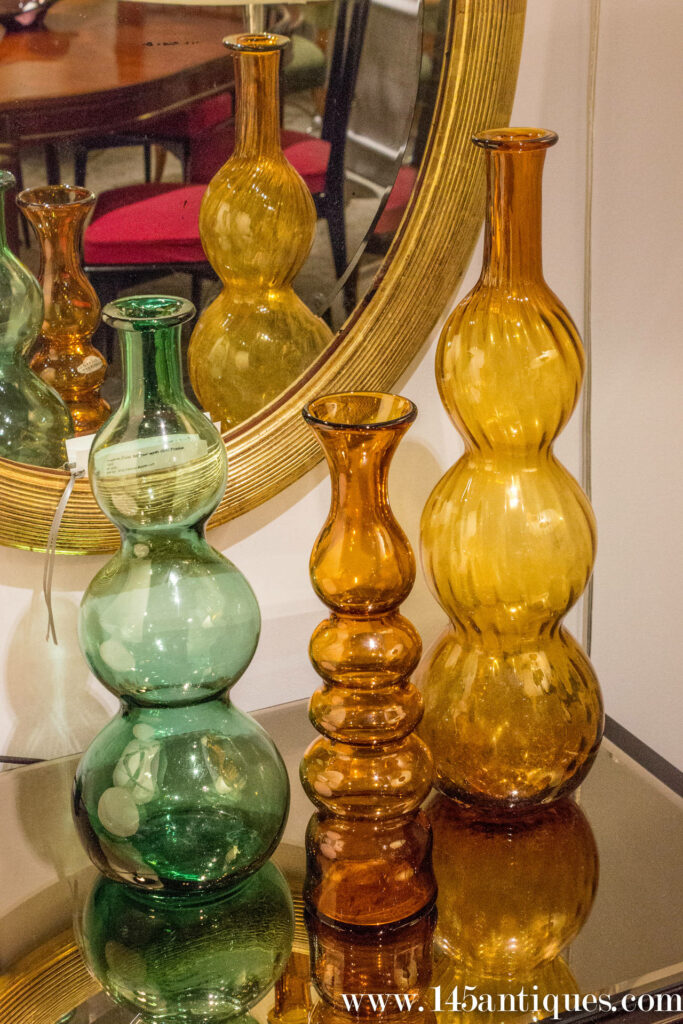
Carnival glass
Carnival glassware was popularized in the early 20th century, known for its iridescent appearance and intricate patterns.
On a historical note, carnival glass gets its name from the fact that it was often given as prizes at carnivals and fairs. Its shimmering, rainbow appeal occurs when artisans apply a layer of metallic salts to the surface. If you own carnival glassware, it's important to handle it with care to avoid damage, as the iridescent coating can be delicate.
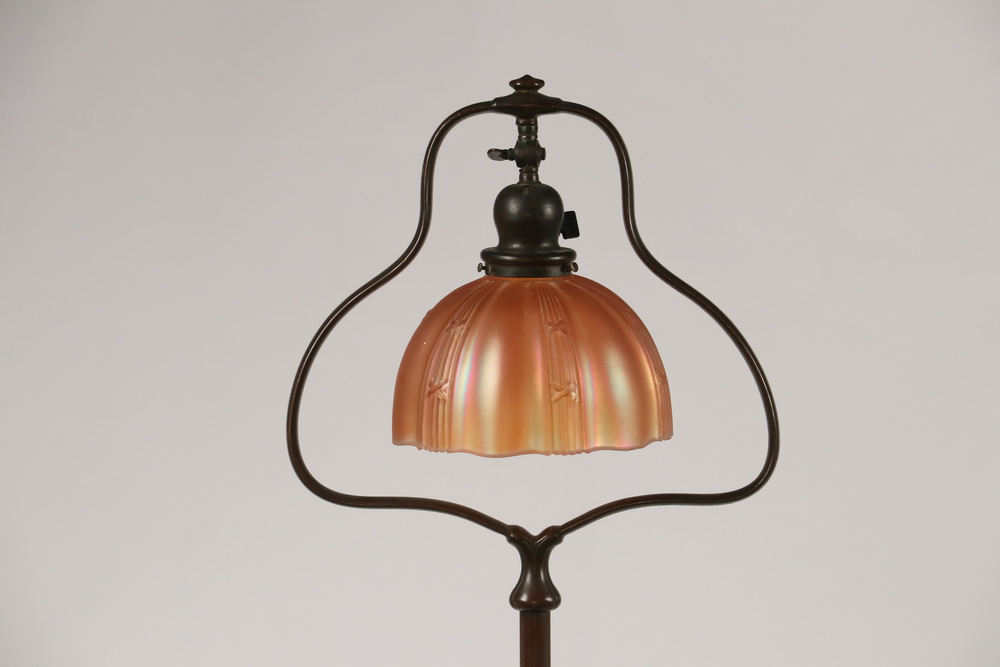
While carnival glass was initially produced as a more affordable alternative to expensive art glass, it gained popularity among collectors due to its unique appearance and historical significance. Today, it is cherished as a nostalgic and decorative collectible.
An example we sold at auction includes this Arts & Crafts bronze floor lamp with the shade made of orange carnival glass for $840 in 2017.
Milk glass
Milk glassware refers to a type of opaque glass resembling the color of milk. It has a distinctive white or creamy appearance and a smooth, non-transparent surface.
No, it does not contain milk within the glass.
Milk glass was first produced in the 16th century and gained popularity in the 19th and 20th centuries. It was commonly used for tableware, but has expanded into general decor.
It is made by adding opacifying agents, such as tin oxide or bone ash, to the glass mixture during the manufacturing process. These agents give the glass its milky and opaque appearance.
An example we sold in the past is this 19th C. brass student oil lamp with a milk glass shade, with the price at $150.
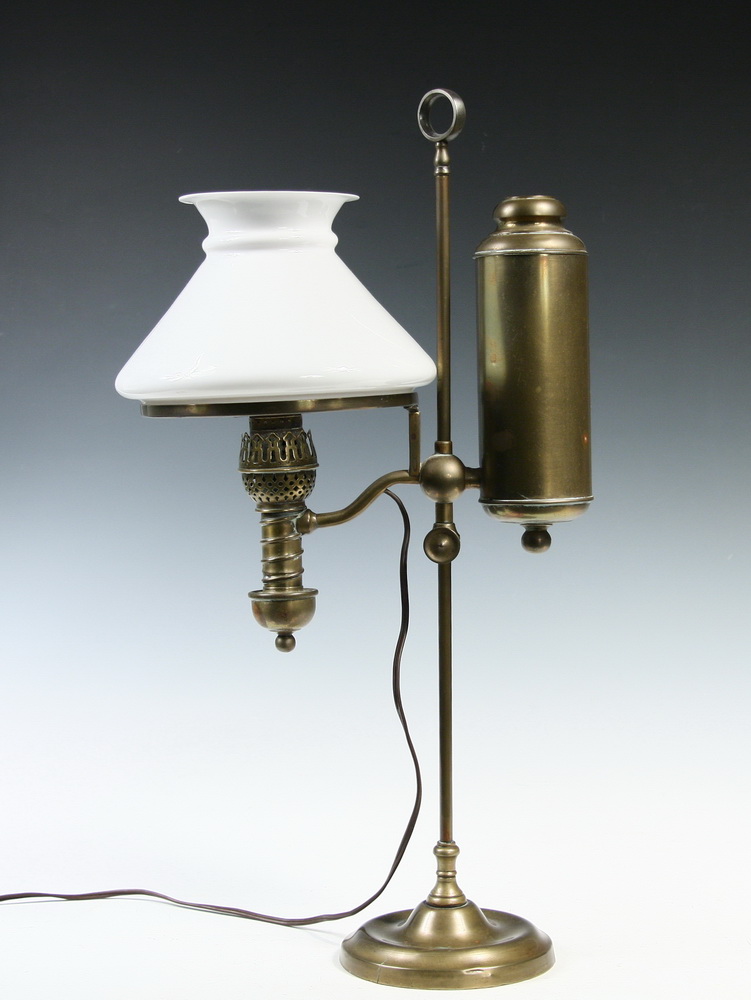
Opalescent
Opalescent glassware exhibits a play of colors, similar to opal stones. It has a translucent or semi-transparent appearance with a captivating iridescent effect.
Opalescent glass is created by incorporating specific chemicals, like fluorides or phosphates, into the glass mixture during the manufacturing process. These chemicals cause the glass to have a milky or cloudy appearance, and when light passes through, it scatters and refracts, producing a stunning display of colors.
The colors visible in opalescent glassware can vary, but they often include shades of blues, pinks, purples, and greens. The glass may have a base color with contrasting or complementary hues appearing as highlights or swirls.

Opalescent glass is highly valued by collectors and enthusiasts due to its unique and ethereal appearance. It adds a touch of elegance and vintage charm to any space, whether displayed as a standalone piece or used for serving and entertaining.
A fine example we sold in a previous auction is this signed Lalique vase, which sold for $1,725 in 2015.
Satin
Satin glassware refers to a type of glass with a matte finish, resembling the texture of satin fabric. It has a soft and diffused appearance, differentiating it from the usual glossy or transparent glass.
One common method to achieve this appearance involves etching or acid treatment, which creates a frosted or opaque surface. Another technique is sandblasting, where fine particles of sand are used to create a matte finish.
Satin glass can be found in a variety of forms, including vases, bowls, lampshades, and decorative objects. It is known for its understated beauty and often features gentle curves or intricate patterns. Some pieces may also incorporate other decorative elements like hand-painted designs or raised textures.
Satin glass is appreciated for its diffused and muted appearance, creating a sense of gentle elegance. It is often used as decorative items, displayed on shelves or tables to add a touch of sophistication to a space.
If you own satin glass, it's important to handle it with care to avoid scratching or damaging the delicate finish. Regular gentle cleaning using mild soap and water is usually sufficient to maintain its beauty.
Satin glassware stands out for its subdued and velvety texture, making it a desirable choice for collectors and those seeking a unique and sophisticated glassware option. Its matte finish offers a distinct look that adds a touch of refinement to any interior décor.
A final example that sold with us is this art nouveau French satin glass vase, in a gorgeous green shade, for $550 in 2010.

There are multitudes of other collectible antique glass, ones that we don’t frequently see here at our gallery. But with the amount of antique stores and flea markets around bearing all kinds of glass art, the world is your (glass) oyster! Antique glass is a creative and sustainable way to provide a beautiful and elegant touch to any space whether it’s through tableware, artful displays or simply to bedazzle your fireplace mantle depending on the season.
Are you interested in starting or growing your glass collection further? Subscribe for our e-newsletter and be notified whenever glass antiques come up for auction!
